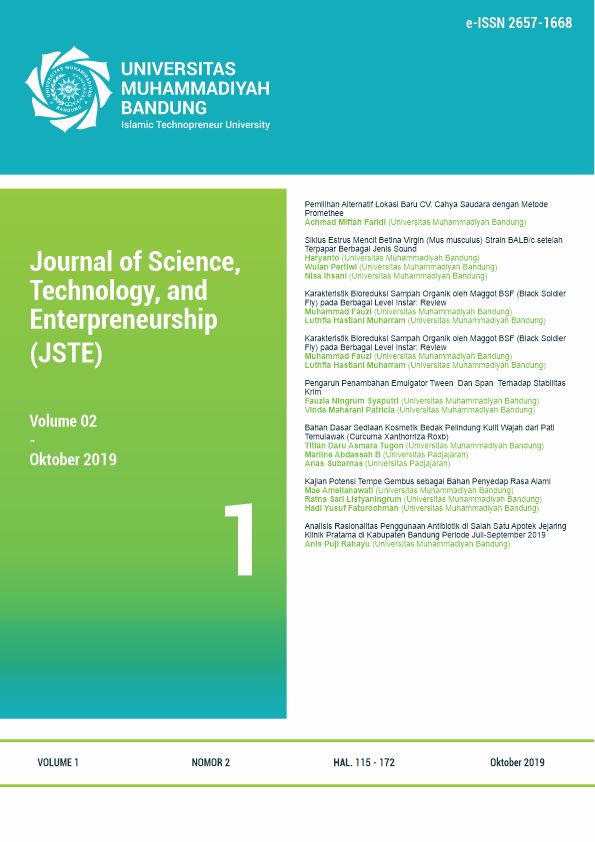Bahan Dasar Sediaan Kosmetik Bedak Pelindung Kulit Wajah dari Pati Temulawak (Curcuma Xanthorriza Roxb)
Kata Kunci:
strach, temulawak, cosmetics, powder, SPF (Sun Protection Factor)Abstrak
The process of developing temulawak starch has not been done much, especially in the cosmetics field. Temulawak rhizome extraction to produce starch was done by smoothing the temulawak rhizome, then squeezed. After that the juice that had been obtained was soaked with solvent for 2 days and the replacement of the solvent was done once a day. The end result was dried and used as a basic ingredient in making face protection skin powder. The production of the sprinkled powder and cold powder from temulawak starch as a basic ingredient was then evaluated (organoleptic test, homogeneity, pH, particle size distribution and in vitro effectiveness test (determination of SPF value). Organoleptically, the springkled powder and cold powder with temulawak starch as an ingredient the superiority could be recognized from the color without the addition of coloring agent. The F1 sprinkled powder was olive powder with SPF value 13.99, and the F2 sprinkled powder was ivory/cream yellow with SPF value 12.33. The F1 cold powder was olive powder with SPF value 15,58, and the F2 cold powder was ivory/cream yellow with SPF value of 14.44 using a positive control of powder circulating on the market with an SPF value of 15. According to Damgalad (2013), SPF value of 8-15 is in the maximum stage. Sprinkled powder and cold powder made from temulawak starch ingredients were then declared to have protection against UV exposure at the maximum stage
Referensi
Lee, A., &Kaplan, M.D., 1992, Suntan, Sunburn, and Sun Protection, Journal of Wildernes Medicine 3, 174-175, 179
Retno Iswari T. & Fatma Latifah. 2007. Buku pegangan ilmu pengetahuan kosmetik. Jakarta: Gramedia Pustaka Utama
Masaki.2010. Role Of Antioxidant In The Skin: Ant-Aging Effects. Jounal of Dermatologial Sciene, 58, 85-90.
Momtaz S., Mapunya, B.M., Houghton, P.J., Edgerly, C., Hussein, A., Naidoo, S. dan Lall, N. 2008. Tyrosinase Inhibition by Extracts And Constituents of Sideroxylon inerme L. Stem Bark, Used In South Africa For Skin Lightening, J. of Ethnopharmacology 119: 507–512
Masuda T, Isobe J, Jitoe A, Naktani, Nobuji. 1992. Antioxidative curcuminoids from rhizomes of Curcuma xanthorrhiza. Phytochemistry. 31(10): 36453647.
Jitoe A, Masuda T, Tengah IGP, Suprapta DN, Gara LW,Nakatani N. 1992. Antioxidant activity of tropical ginger extracts and analysis of the contained curcuminoids. J Agric Food Chemistry. 40: 1337-1340.
Priyadarsini, K.I., Maity, D.K., Naik, G.H., Kumar, M.S., Unnikrishnan, M.K., Satav, J.G., dan Mohan, H. 2003. Role of Phenolic OH And Methylene Hydrogen On The Free Radical Reactions And Antioxidant Activity of Curcumin, Free Radical Biology And Medicine, 35(5): 475–484.
Jacobs, H. and J.A. Delcour. 1998. Hydrothermal modifications of granular starch with retention of the granular structure: Review. J. Agric. Food Chem. 46(8): 2895?2905.
Lukitaningsih, Endang. 2009.The exploration of whitening and sun screening compounds in bengkoangroots(Pachyrhizuserosus).(Online), http://opus.bibliothek.uniwuerzburg.de/volltexte/2009/3956/diakses
Nursal, K.F., Asyarie, S., T.D, Sasanti., Imaculata, M.,2006, Formulasi dan Uji Keamanan serta Aktivitas Krim Pati Beras (Amylum oryzae) dan Pati Jagung (Amylum Maydis) sebagai Tabir Surya, Majalah Farmasi Indonesia, 3 No.2, Desember 2006
Agoes, Goswien. 2015. Sediaan Kosmetika (SFI-9), Penerbit ITB
Subakat,N.2010. Teknologi Formulasi dan Pengembangan Produk Kosmetik. Seminar Nasional Kosmetika Alami dan Presentasi Hasil Penelitian. Yogyakarta
Ratu Inka Kharisma Dianzy dan Dra. Hj. Suhartiningsih, M.Pd. 2015. Pengaruh Proporsi Pati Bengkuang dan Tepung Kacang Hijau Terhadap Sifat Fisik dan Jumlah Mikroba Bedak Dingin. Volume 04 Nomer 01 hal 14-24.
Rukmana, R., 1995 . Temulawak . Tanaman Rempah dan Obat. Penerbit Kanisius, Yogyakarta .
Koswara, S., Citra Ayo Oktavia, dan Sumarto, 2012. Panduan Proses Produksi
Temulawak Instant. Seafast Center LPPM IPB. Bogor.
Sidik, Mulyono MW, Muhtadi A. 1992. Temulawak (Curcuma xanthorriza Roxb). Jakarta (ID) : Yayasan Pengembangan Obat Bahan Alam Phytomedica
Wasitaatmadja, S.M. 1997. Penuntun Ilmu Kosmetik Medik. UI press, Jakarta.
Poskitt, E. M., Cole, T. J., & Lawson, D. E., 1979, Diet, Sunlight, and 25-hydroxy- Vitamin D in Healthy Children and Adults, British Medical Journal, 1, 221
Draelos Z.D and Thaman L.A.,2006 Cosmetic Formulation of Skin Care Products, Draelos, Z.D & Thaman, L.A, eds., Taylor & Francis Group, New York
Sugiharto, Arbakariya, A., Syahida, A., dan Muhajir, H. 2010. Kojic Acid and Curcumin As Tyrosinase Inhibitor To Reduce Hyper Pigmentation In Cell B16-F1, Seminar Nasional Biodiversitas 3, Surabaya–Juli 2010
Damogalad, V., Hosea Jaya Edy dan Hamidah Sri Supriadi. Formulasi Krim Tabir Surya Ekstrak Kulit Nanas (Ananas comosus L Merr) dan Uji In Vitro Nilai Sun Protecting Factor (SPF). Pharmacon Jurnal Ilmiah Farmasi UNSRAT Vol. 2 No. 2. Manado : Program Studi Farmasi FMIPA UNSRAT, 2013.
Mansur, J.S., Breeder, M.N., Azulay, R.D., 1986, Determinação do fator de proteção solar por espectrofotometria, An. Bras. Dermatol, 61, 121-24.
Rowe, Raymon C, Paul J Sheskey, Marian E Quinn.1986. Handbook of Pharmaceutical Excipients. United States America.
Mitsui, T. (1997). New Cosmetic Science. Edisi Kesatu. Amsterdam: Elsevier Science B.V.Hal. 13,19-21.





